On the Road is a weekday feature spotlighting reader photo submissions.
From the exotic to the familiar, whether you’re traveling or in your own backyard, we would love to see the world through your eyes.
It’s Albatrossity Monday, and I thought for a second I might have to schedule this one for after dark! Alas, the babes are baby birbs, which are still totally awesome.
So this week I am away in Michigan, hoping to stay out of trouble this time. But we’ll still have OTR. On Tuesday, we have Uncle Eb with part 6 from the Yucatan, on Wednesday we are in Peru with arrive, and then we have one more day in Argentina with way2blue. On Friday, we are treated to Northen Lights in Iceland with Christopher Mathews.
Albatrossity
We’ll take another break before getting to that last of the Tanzania images. I’ve been seeing and photographing lots of recently-hatched birds here in Flyover Country lately, and I know that birds of this age can often be confusing to birders. So here are some shots of young birds, juxtaposed with an adult of the same species. All of the youngsters (left side in each composite photo) were photographed this year, some of the adult birds (at right in the composites) are from previous years.
There are a few generalities to help with IDing a young bird of any species.
- Typically the plumage is duller in color than the adult plumage.
- Typically, the feathers are loose-fitting, particularly the undertail coverts; most northern hemisphere birds will molt in the fall and get a more winter-worthy set of feathers.
- Typically the feathers are quite fresh-looking, without the nicks and gaps that can be seen in adult feathers at this time of year.
- Once they are out of the nest, some young birds are smaller than the adults, especially those we call “precocial” (capable of feeding themselves immediately, like ducks and shorebirds); but most are the same size or even slightly larger than adult birds of the same species.
- Many are instantly recognizable because they follow around and beg from an adult bird.
- If the adult males and females have different plumages, a hatch-year bird will generally look more like the females.
- And finally, as noted previously, many young birds retain a fleshy yellow gape from the nestling stage.
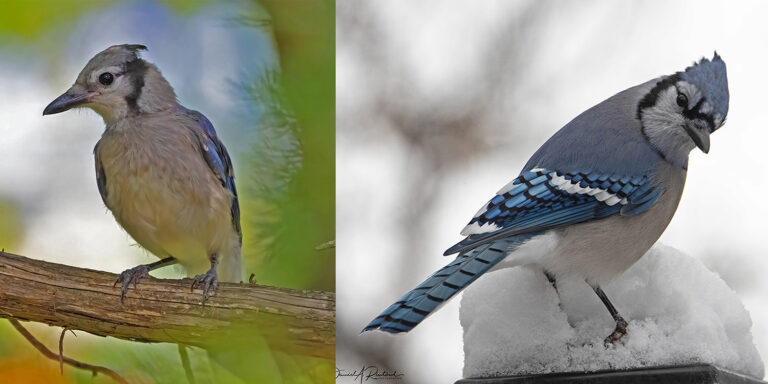
Our first pair is the instantly recognizable Blue Jay (Cyanocitta cristata). In the young bird at left, note the yellow fleshy gape, loose and sparse feathers (check out that wispy crest!), and generally duller colors than the adult at right. Click here for larger image.
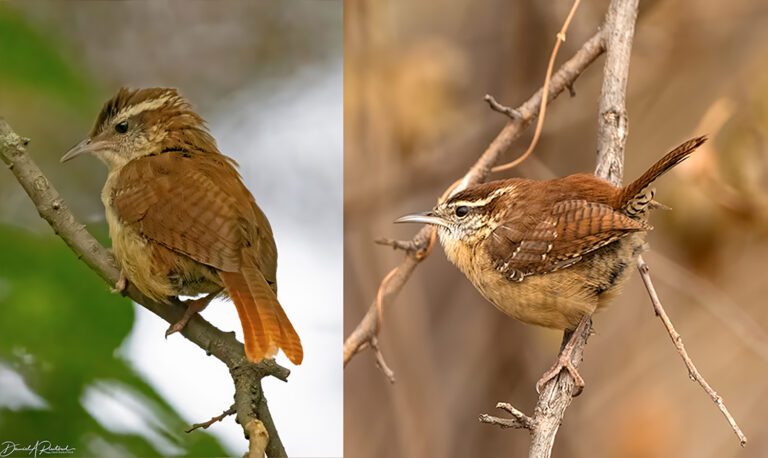
Carolina Wrens (Thryothorus ludovicianus) are a bit more subtle. But the young bird at left has duller plumage (compare the wing feathers with the white-spotted and dark-barred wings of the adult at right), and loose-feathered look. This one was also following an adult around and begging, so the ID was pretty easy. Click here for larger image.
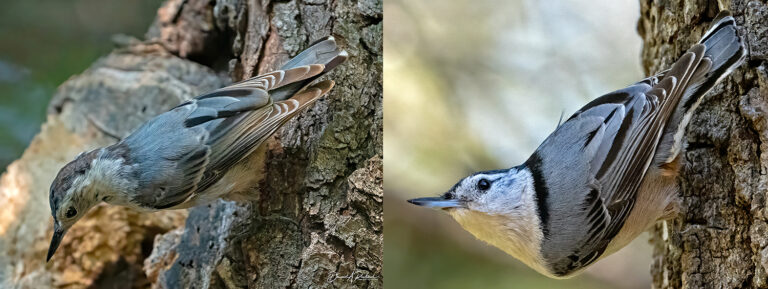
Another familiar backyard bird, the White-breasted Nuthatch (Sitta carolinensis) youngster at left is duller colored (especially note the brown tones on the crown, which is solid black on an adult), and has a scruffy, loosely feathered look. Another clue is the fresh buffy edging on the wing coverts and the longer wing feathers, which is missing on the adult at right. Click here for larger image.
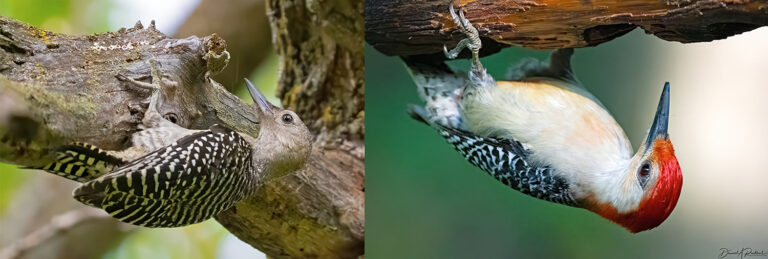
Red-bellied Woodpecker (Melanerpes carolinus) juveniles, like the one at left here, don’t have red feathers on the head, whereas both male and female adults (male adult at right) do have red crowns and/or napes. Dull colors but fresh feather edges are also obvious in the youngster. Click here for larger image.
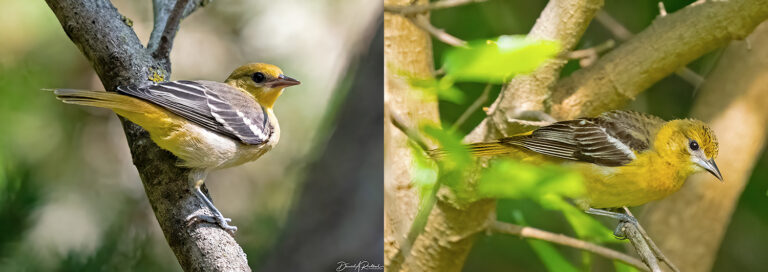
Our backyard Baltimore Orioles (Icterus galbula) had a productive summer this year; the bird at left is one of three youngsters who were pestering the adults for food one day. Adult male and female Baltimore Orioles have different plumages, and as mentioned above, the young bird resembles the adult female at right. The adult is perhaps more orangey than the lemon-yellow hatch-year bird, but also has beat-up edges on the wing feathers (compare the white wing-bar feathers in these two birds), whereas the youngster has crisp and clean edging on its feathers. Click here for larger image.
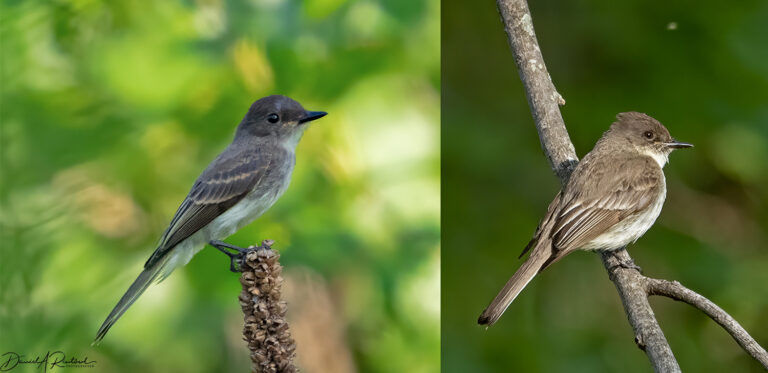
Feather wear is also easy to see on the adult Eastern Phoebe (Sayornis phoebe) at right. Additionally, the young bird at left has a fleshy yellow gape and buffy edging on the wing coverts, making it appear to have wing bars. Click here for larger image.
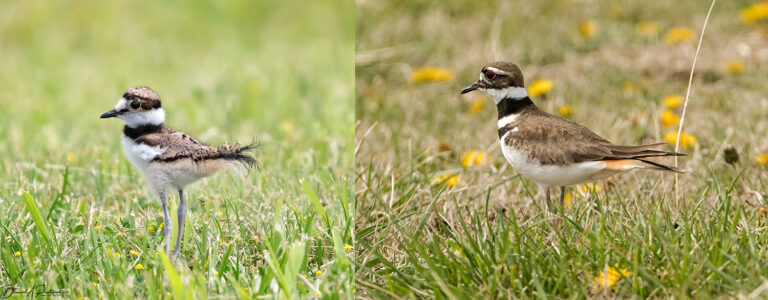
This is a precocial species, so the young Killdeer (Charadrius vociferus) at left is significantly smaller than the adult at right. It also has that loose-feathered look mentioned above, and it (along with its three siblings) was scurrying around foraging in the grass, but they were accompanied by a pair of adults. Click here for larger image.
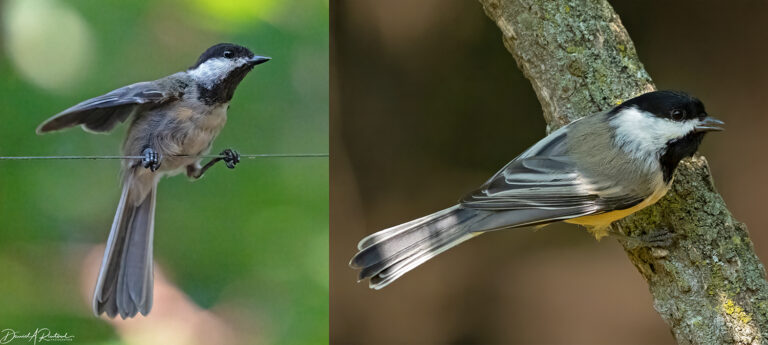
This example is a bit more subtle. Black-capped Chickadees (Poecile atricapilla) are year-round residents across northern North America, but are not very colorful, and exhibit no sexual dimorphism in the plumage. Young birds also look a lot like adults. But there are some differences, which are frankly easier to see if you have the bird in the hand or get a good photograph rather than trying to focus on such small flighty birds in the field. The young bird at left has fluffy loose plumage compared to the adult at right, but it also has what the bird-banding bible (Pyle, Identification Guide to North American Birds, Part I, 1997) describes as a “slightly duller (sooty) black cap” compared to adult birds. These images were also chosen to highlight another subtle difference, the pattern of white on the outermost tail feather. The young bird has a pointier feather with a white stripe only on the outer vane; the adult bird has a more rounded feather tip, and the white stripe wraps around the tip onto the inner vane. So make sure you look for that in your backyard chickadees! Click here for larger image.
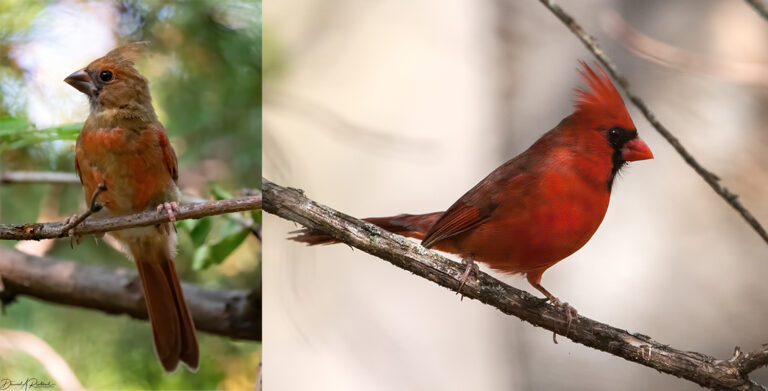
Northern Cardinals (Cardinalis cardinalis) also had a good season in our neighborhood this summer. This stalwart youngster at left shows the loose feathering (again, a very wispy crest) and fresh feather edges of a typical youngster. Not so typical is that cardinals are one of the few species that can be sexed as juveniles; male fledglings like the one here have red feathering on the body, whereas females may have red on the wings or tail, but not on the body. Young cardinals, regardless of sex, also have a blotchy dark bill, compared to the adult male’s bill at right. Click here for larger image.
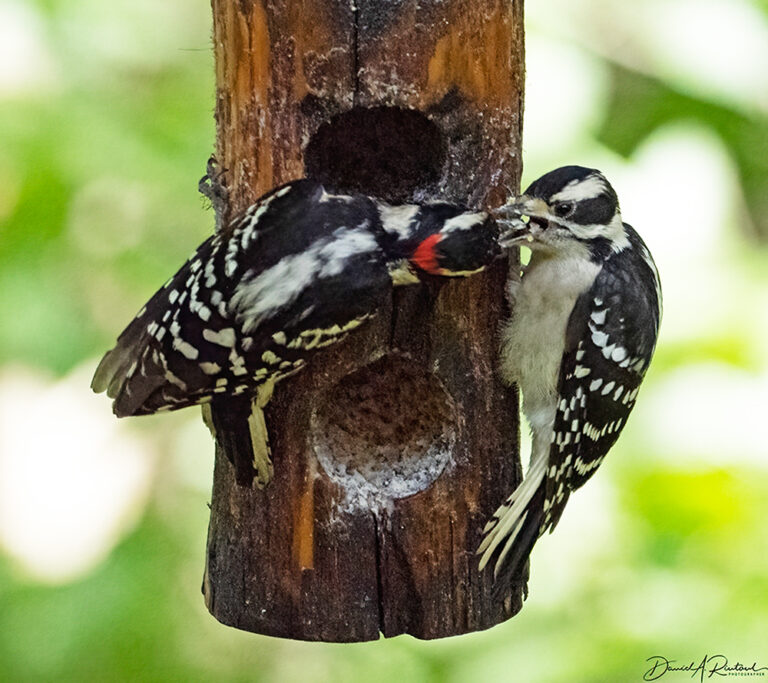
The suet feeder in our yard has been very popular this year; I have to refill it every 3-4 days. Here it is a site for a male Downy Woodpecker (Picoides pubescens) at left to feed a young female (right). She was feeding there quite successfully before the adult male dropped in, at which time she switched to helpless begging mode. As with cardinals, young Downy Woodpeckers can be sexed as fledglings, a hatch-year male would have some red feathers on the head. Here’s a video of this pair. Note that the young bird is the same size, and maybe even a bit larger, than her hard-working dad. Click here for larger image.

 Family Is Family – Notes From OzarkHillbilly and Renee
Family Is Family – Notes From OzarkHillbilly and Renee
eclare
So interesting! That female Downy Woodpecker must have been pissed to lose her good feeder spot! Blame it on The Man and go see Barbie.
Kristine
Thanks for these photos and the explanations.
Last year I spotted a lovely black and white bird I’d never seen before. I wondered if a new breed had shown up in the area until I saw it with a pair of red-headed woodpeckers. Yup, it was their baby.
I liked watching one of the parents feed baby at the suet feeder.
SteveinPHX
Very cool idea to do this. Educates me!
Thank you again!
JeanneT
What a good idea! We’re a few weeks past the fledgling stage of our resident robins and I’ve never had problems spotting the very youngest juveniles from those adults but now I can pay more attention to the bluejays and cardinals to see if I can spot this year’s young. Cool!
BretH
Thanks, that was really informative!
SW
There is a gang of ravens that hang around our neighborhood. One of them, pretty much indistinguishable from the others is always squawking and begging to be fed. The others occasionally stop what they are doing to feed him. Like he is an annoying big baby who needs to be indulged. It is odd. It is just the one bird who exhibits this behavior out of a flock of probably 12 to 15 birds.
Redshift
I saw a female cowbird on my street this week. As a very casual birder, I’ve seen cowbirds, since they’re pretty distinctive ,but I never looked them up so it hadn’t occurred to me that they had dimorphism. But there were two of them foraging in the company of a grey bird, and I thought “I wonder if that’s a female?” And it was!
Dr. Jakyll and Miss Deride
Gorgeous as always, plus educational! While you’re at it, I have a couple of questions, which will test the adage “There are no dumb questions.”
The great but forgotten comedian Jackie Vernon always used to say: “A wet bird never flies at night.” True?
I’ve often heard that birds of a feather flock together–but how do they fly? Don’t you need more than one feather?
Albatrossity
@Dr. Jakyll and Miss Deride:
I don’t know. I don’t get out much at night; there are not enough photons
Dumbo only needed one feather! Of course, he was not a bird. Nor was he a flock… Excellent question. Next time you encounter an ornithologist at a cocktail party, see if you can get an answer!
Chat Noir
Beautiful pictures and educational as always. Thank you!
Madeleine
Several years ago we saw a young cardinal, quite red but too small to be an adult, on a low branch of a tree at our kitchen window. We were concerned that it had fallen from the nest, so I got in touch with a birder I knew. She told me that this is typical behavior as the bird nears fledging and we should just let it be. We had been unaware of the nest, though we were pretty attentive to birds around our townhouse. A memorable experience.
And thank you, Albatrossity. This is a fascinating post.
mvr
Thanks for the education!
Out in Wyoming we have a Cordilleran Fly Catcher incubating two eggs on one of the beams of our cabin. When we arrived two weeks ago we found an ant infestation in the roof and had to remove and reinstall the whole metal roof to deal with the ants. Then we went to Yellowstone for a week and came back to finish up a few days ago. Throughout it all the Fly Catcher continued to sit on the eggs on a regular basis, though when it was warm she/he was less likely to stick around through our disturbing work. His her mate was often in the nearby trees exchanging calls.
I hope to go back out there in about two weeks. I imagine the young will have fledged by then, but I could be wrong. It will be interesting to see how they differ from mom/dad.
The Fly Catcher nest on some part of the cabin has been a regular thing since we built it 15 years or so ago.
Anyway, thank you once again for your work!
Albatrossity
@mvr: Wow, that is one persistent momma bird. We currently have a Carolina Wren incubating 5 eggs in a nest above our front entrance. She seems OK with folks going in or out, but will bail from the nest if anyone dawdles out there!
BTW, the taxonomical powers-that-be have re-lumped Cordilleran and Pacific-slope Flycatcher into their old status as a single species, Western Flycatcher. So all the field guide authors will have to catch up!
StringOnAStick
I Love that you’re giving us your insights,, I learned a lot.
Currently a pair of hummingbirds have a nest in the tall native juniper next to our fence; they’ve claimed our backyard as their nectar resource and have done an excellent job chasing off the scrub jays to protect their nest; I haven’t seen it but the neighbours and I are sure there is one. The most popular nectar plants we have are the tall and rangy Redbirds in a Tree and the agastaches that will bloom until fall. I’m loving seeing the amazing array of pollinators this year; if you grow it (and don’t poison it), they will come.
mvr
@Albatrossity: Interesting about the collapse of species identities. This is a bird I was actually able to identify myself using a guide of Rocky Mountain birds first and then another of continent wide birds to confirm. And now, having gotten a Merlin App on my phone, it too agrees. So there will be lots of taxonomic updating to be done.